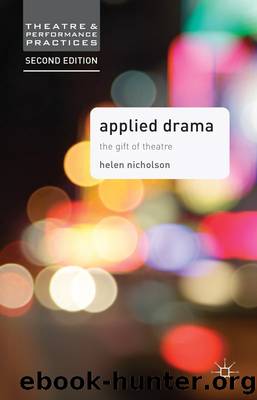Applied Drama: The Gift of Theatre by Helen Nicholson

Author:Helen Nicholson [Nicholson, Helen]
Language: eng
Format: epub
Tags: Performing Arts, theater, Direction & Production, History & Criticism, General, Social Science
ISBN: 9781137242570
Google: Z-bnCgAAQBAJ
Publisher: Macmillan International Higher Education
Published: 2015-10-01T00:03:31.408523+00:00
A Phenomenology of Community
Vered Amit offers a sceptical account of theoretical constructions of community, arguing that they have neglected to account for actual relationships of intimacy and social bonds. Although she suggests that in principle forms of identification are âquite portableâ, a sense of belonging to communities beyond the immediate experiences of everyday living often only lasts for the duration of actual emotional or familial ties, and becomes watered down over time.34 Following Merleau-Pontyâs phenomenological idea of âbeing in the worldâ, I should like to extend Amitâs account of how social experiences can turn into personal intimacies and social networks and make a case for the significance of the body in feelings of community. This is intended, following Nancy, to move the discussion of community-building beyond the idea that communities are either imagined or constructed through âface-to-faceâ interactions, as if the rest of the body were somehow invisible. As an illustration, my aim is to examine narratives of ageing in order to consider how the actual social experience of community involves what Merleau-Ponty described as âbody-knowingâ, an embodiment of personal and collective narratives.
What I am searching for here are ways of working in theatre which respect the relationship between the affective body and the various narratives of place and community through which identities are formed and reshaped. Places and experiences are not only inscribed on the body, but are integral to its material presence; our physicality and sense of being in the world are integral to the archaeology of identity, contributing to the âhistorical sedimentationâ of selfhood, to borrow Kate Soperâs memorable phrase.35 Elspeth Probyn sees the embodiment of locality as symptomatic of oppression:
In conceiving of the local as a nodal point, we can begin to deconstruct its movements and its meanings. Thus, in thinking how locale is inscribed on our bodies, in our homes, and on the streets, we can begin to loosen its ideological effects.36
Boal extends this perspective, describing how the body becomes âhardened by habit into a certain set of actions and reactionsâ.37 Linking memory, emotion and the body, Boal claims that the habitual repetition of movement is personally and politically limiting. In certain contexts this is, of course, painfully obvious. I vividly remember a Tamil primary school teacher in Sri Lanka showing me how his body had been irrevocably scarred by the beatings he had sustained at the hands of the âpeacekeepingâ Indian army who had attacked him after a school football match. Boalâs use of dramatic strategies to deconstruct how experience has been etched on the body is explicitly political; his drama is about âde-mechanising, de-structuring, dismantlingâ the effects of daily life.38 Boalâs objective, Philip Auslander explains, is to enable participants in the drama to liberate themselves from this physical oppression, but in the process he labours under the misapprehension that it is possible for the body to escape âideological encodingâ.39
Whilst Boalâs reading of the living body is an important reminder of how histories are carried physically, the idea that the body is marked by
Download
This site does not store any files on its server. We only index and link to content provided by other sites. Please contact the content providers to delete copyright contents if any and email us, we'll remove relevant links or contents immediately.
Kathy Andrews Collection by Kathy Andrews(11674)
The remains of the day by Kazuo Ishiguro(8733)
Paper Towns by Green John(5022)
Spare by Prince Harry The Duke of Sussex(4991)
The Body: A Guide for Occupants by Bill Bryson(4876)
Industrial Automation from Scratch: A hands-on guide to using sensors, actuators, PLCs, HMIs, and SCADA to automate industrial processes by Olushola Akande(4825)
Machine Learning at Scale with H2O by Gregory Keys | David Whiting(3944)
Be in a Treehouse by Pete Nelson(3874)
Harry Potter and the Goblet Of Fire by J.K. Rowling(3733)
Never by Ken Follett(3697)
Goodbye Paradise(3658)
Into Thin Air by Jon Krakauer(3256)
The Remains of the Day by Kazuo Ishiguro(3250)
The Cellar by Natasha Preston(3214)
The Genius of Japanese Carpentry by Azby Brown(3185)
Fairy Tale by Stephen King(3150)
120 Days of Sodom by Marquis de Sade(3110)
Drawing Shortcuts: Developing Quick Drawing Skills Using Today's Technology by Leggitt Jim(2958)
The Man Who Died Twice by Richard Osman(2951)
